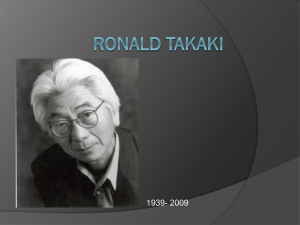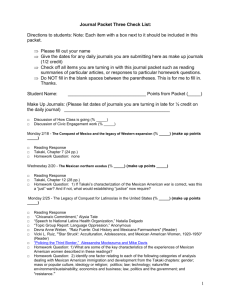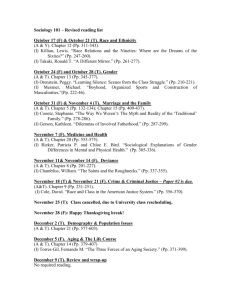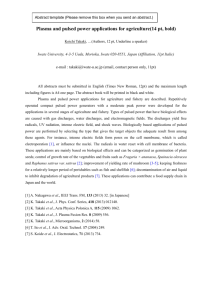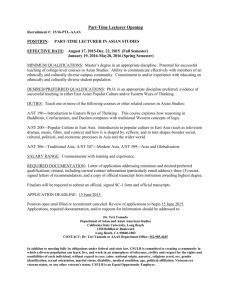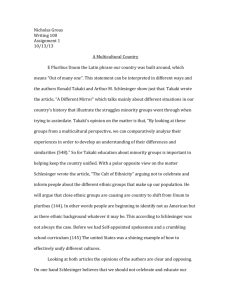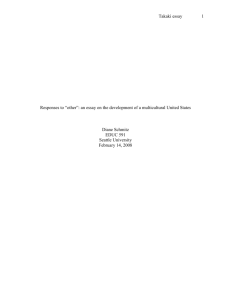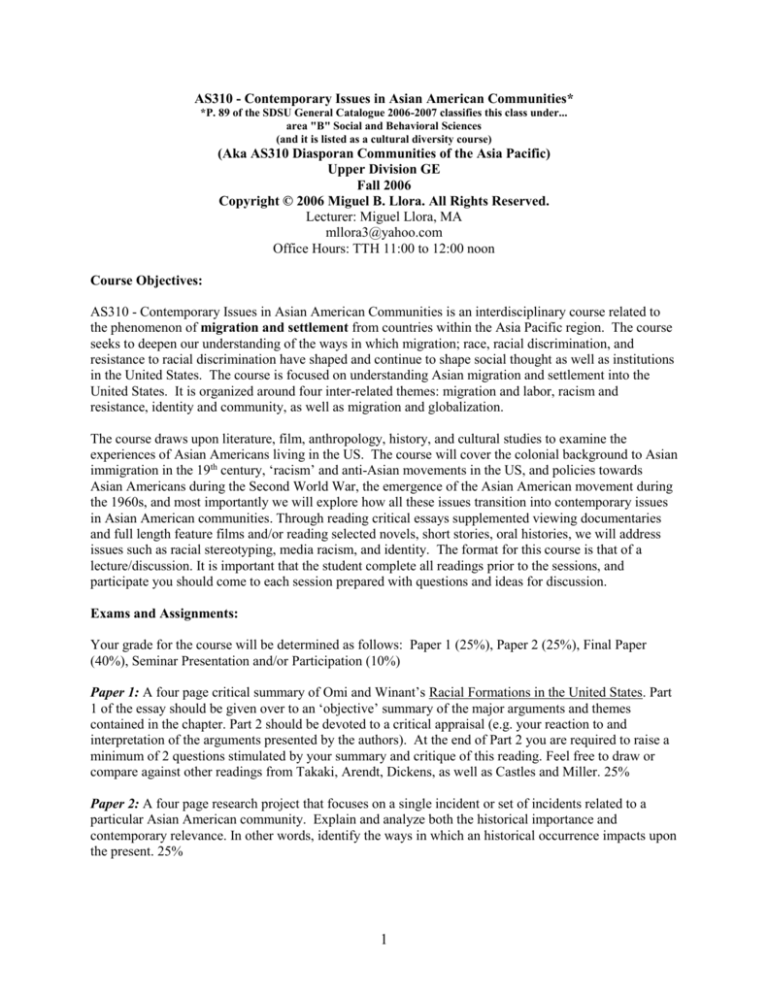
AS310 - Contemporary Issues in Asian American Communities*
*P. 89 of the SDSU General Catalogue 2006-2007 classifies this class under...
area "B" Social and Behavioral Sciences
(and it is listed as a cultural diversity course)
(Aka AS310 Diasporan Communities of the Asia Pacific)
Upper Division GE
Fall 2006
Copyright © 2006 Miguel B. Llora. All Rights Reserved.
Lecturer: Miguel Llora, MA
mllora3@yahoo.com
Office Hours: TTH 11:00 to 12:00 noon
Course Objectives:
AS310 - Contemporary Issues in Asian American Communities is an interdisciplinary course related to
the phenomenon of migration and settlement from countries within the Asia Pacific region. The course
seeks to deepen our understanding of the ways in which migration; race, racial discrimination, and
resistance to racial discrimination have shaped and continue to shape social thought as well as institutions
in the United States. The course is focused on understanding Asian migration and settlement into the
United States. It is organized around four inter-related themes: migration and labor, racism and
resistance, identity and community, as well as migration and globalization.
The course draws upon literature, film, anthropology, history, and cultural studies to examine the
experiences of Asian Americans living in the US. The course will cover the colonial background to Asian
immigration in the 19th century, ‘racism’ and anti-Asian movements in the US, and policies towards
Asian Americans during the Second World War, the emergence of the Asian American movement during
the 1960s, and most importantly we will explore how all these issues transition into contemporary issues
in Asian American communities. Through reading critical essays supplemented viewing documentaries
and full length feature films and/or reading selected novels, short stories, oral histories, we will address
issues such as racial stereotyping, media racism, and identity. The format for this course is that of a
lecture/discussion. It is important that the student complete all readings prior to the sessions, and
participate you should come to each session prepared with questions and ideas for discussion.
Exams and Assignments:
Your grade for the course will be determined as follows: Paper 1 (25%), Paper 2 (25%), Final Paper
(40%), Seminar Presentation and/or Participation (10%)
Paper 1: A four page critical summary of Omi and Winant’s Racial Formations in the United States. Part
1 of the essay should be given over to an ‘objective’ summary of the major arguments and themes
contained in the chapter. Part 2 should be devoted to a critical appraisal (e.g. your reaction to and
interpretation of the arguments presented by the authors). At the end of Part 2 you are required to raise a
minimum of 2 questions stimulated by your summary and critique of this reading. Feel free to draw or
compare against other readings from Takaki, Arendt, Dickens, as well as Castles and Miller. 25%
Paper 2: A four page research project that focuses on a single incident or set of incidents related to a
particular Asian American community. Explain and analyze both the historical importance and
contemporary relevance. In other words, identify the ways in which an historical occurrence impacts upon
the present. 25%
1
Final Paper: A seven-page comparative analysis of Takaki’s Strangers from a Different Shore. This
essay should focus on at least two of the Asian American populations referred to in the text. Paper needs
to include analysis of filmic representation of the groups under consideration. How are the groups
identified and represented? How were their experiences similar and different? What were their defining
racial and ethnic characteristics of each group as defined by the dominant ‘majority’? What factors
account for their relative position and status contemporary American society? 40%*
*Breakdown: The 40% is divided into 10% for an outline and 30% for the finished product. To get the
full 10%, the outline must include a cover sheet, the outline, and your list of references (in MLA format).
The practice of formulating your ideas and argument flow through the outlining of your topics is a time
tested technique that I fully endorse and for the final paper require.
Seminar Presentation: Since this a “Contemporary Issues in Asian American Communities” class, the
presentation will have to be based on a topic. Time permitting; this presentation is a group presentations
(using PowerPoint) on a topic mutually agreed upon with the professor. If time does not permit, I will use
attendance and class participation instead. 10%
The papers need to be done strictly according to MLA format. It is strongly recommended that
students attend individual tutorials with me to discuss and plan their research projects.
Required Readings:
Takaki, Ronald. Strangers from a Different Shore: A History of Asian Americans. Boston: Little, Brown
and Company, 1998
Note: All required readings on the syllabus (aside from Takaki) will be available ONLINE
via Blackboard and ECR or HARDCOPY at the SDSU Reserve Book Room.
CLASS SCHEDULE & LECTURE OUTLINES
Week 1 - Aug. 29 - 31: Introduction
The course syllabus: philosophy; approach; expectations and requirements
Course goals and objectives: comparative analyses of immigration; a re-visioning of history;
understanding the contemporary world
What is Asian American history?
What do you expect from this course?
Reading: Takaki 3-21
Video:
Stuart Hall: Race - The Floating Signifier (22581)
TV7471V
Stuart Hall: Representation And The Media (23670)
TV8583V
Further Reading:
Chan, Sucheng. Asian Americans – An Interpretive History. Boston: Twayne Publishers, 1991.
Literature
Woman Warrior by Maxine Hong Kingston
America Is in the Heart: A Personal History by Carlos Bulosan
The Gangster of Love by Jessica Hagedorn
Dogeaters by Jessica Hagedorn
Week 2 - Sept. 5 - 7: Geographies of Asian Immigration
European colonialism and Asia, western expansion and Asian migrations, Asia in the colonial
imagination; race in 19th century European and American thought, “Manifest Destiny” and continental
empire, and early Asian arrivals in north America.
Reading: Said xi-xxviii (provided)
2
Arendt 124-134 (provided)
Dickens Great Expectations – Afterword (provided)
Video:
Edward Said On Orientalism (22580) 1998
TV7470V
Great Expectations (1946)
DVD-863
Great Expectations (1998)
(Lecturer's Collection)
Further Reading:
Arendt, Hannah. The Origins of Totalitarianism. Cleveland: Meridian Books, 1969.
Said, Edward. Culture and Imperialism. New York: Vintage Books, 1994.
Week 3 - Sept 12 - 14: Early patterns of Asian Immigration
The United States as a colonial power: ‘Opening’ Asia; Asia as Far East or Far West? Understanding the
‘Push-Pull paradigm: conditions in countries of origin; conditions in the United States; ‘rational choice’
and immigration; limits of the push-pull paradigm, Gender and immigration (picture brides), destination
countries other than the United States and Canada, The ‘coolie’ trade and human trafficking, sojourners
and immigrants: why some stayed and others did not; laborers, political exiles, intellectuals, aliens and
nationals, and commonalities and differences.
Reading: Takaki 132-147
Castles and Miller 18-42 (provided)
Video:
Wataridori: Birds Of Passage (22503)
TV7545V
Further Reading:
Castles, Stephen and Miller, Mark. The Age of Migration: International Populations Movements in the
Modern World 2nd Edition. London: The Guilford Press, 1998.
Week 4 - Sept. 19 - 21: Crossing Borders: The United States as a ‘Nation of Immigrants’
Immigration and assimilation; and the vocabulary of immigration, migration and settlement
Reading: Takaki 132-178
Omi and Winant 57-69 (provided)
Further Reading:
Omi, Michael and Winant, Howard. Racial Formation in the United States, 2nd edition. New York and
London: Routledge, 1994.
PAPER 1 – DUE SEPTEMBER 21, 2006
Week 5 - Sept. 26 - 28: Labor, Economic Competition and Cultural Attitudes
Perpetual Aliens, Samuel Gompers and organized labor, the business perspective, the radical labor
perspective and class interests, missionaries and the paradox of America, and African Americans and
Chinese and Japanese immigrants.
Reading: Takaki 147-162
Video:
Picture Bride
(Lecturer's Collection)
Week 6 - Oct. 3 - 5: Seeing Brown and Yellow: “coloring” the landscape of America
Exploring race in filmic representations in U.S. popular culture.
Reading: Aguilar-San Juan 161-171 (provided)
Video:
In Class Film: Yellow Fever
(Lecturer's Collection)
Cheat (1915)
(Lecturer's Collection)
The Thief of Bagdad (1924)
(Lecturer's Collection)
The Good Earth (1937)
(Lecturer's Collection)
3
Bombs over Burma (1942)
(Lecturer's Collection)
Lady from Chunking (1943)
(Lecturer's Collection)
The Adventures of Dr. Fu Manchu, 4 Full-Length Episodes (1950s) (Lecturer's Collection)
The Castle of Fu Manchu (1969)
(Lecturer's Collection)
Further Reading:
Aguilar-San Juan, Karin, Ed. The State of Asian America: Activism and Resistance in the 1990s. Boston:
South End Press, 1994.
Media and Popular Culture
Curran, James, and Gurevitch, Michael. Mass Media and Society. New York: Arnold Publishing, 2000.
Kwok, Jenny Wah Lau. Multiple Modernities: Cinema and Popular Media in Transnational Asia. Temple:
Temple University Press, 2003.
Lee, Josephine; Lim, Imogene; and Matsukawa, Yuko. Eds. Re/collecting Early Asian America: Essays in
Cultural History. Philadelphia: Temple University Press, 2002.
Lim, Shirley Jennifer. A Feeling of Belonging: Asian American Women’s Public Culture, 1930-1960.
New York: New York University Press, 2006.
Mank, Gregory William. Hollywood Cauldron: Thirteen Horror Films from the Genre’s Golden Age.
London: McFarland & Company, Inc., 1995.
Martinez, Dolores. The World of Japanese Popular Culture: Gender, Shifting Boundaries and Global
Cultures. Boston: Cambridge University Press, 1998.
Napier, Susan J. Anime: From Akira to Princess Mononoke: Experiencing Contemporary Japanese
Animation. New York: Palgrave Macmillan, 2001.
Pomerance, Murray. Ed. Bad: Infamy, Darkness, Evil and Slime on Screen. New York: State University
of New York Press, 2004.
Wollstein, Hans J., Vixens, Floozies, and Molls: 28 Actresses of Late 1920s and 1930s Hollywood.
London: McFarland & Company, Inc., 1999.
http://www.njedge.net/~knapp/FuManchu.htm
Week 7 - Oct. 10 - 12: Legislating Race and Exclusion
Immigration Laws, origins and consequences: Nationality Act of 1790; Naturalization Act of
1870; Burlingame Treaty of 1868; Chinese Exclusion Act of 1882; Gentlemen’s Agreement of 1907;
Immigration Act of 1917 (Asiatic Barred Zone); Immigration Act of 1924, War Brides Acts of 1948,
Filipino and Indian Naturalization Act of 1946; Immigration and Nationality Act of 1952
Yellow Peril in the American imagination; imperialism, race and war; immigrants and the Yellow
Peril; the United States as a ‘racial’ state
Reading: Ancheta 19-40.
Video:
Crash (2004)
DVD 1909
Crash (2004)
(Lecturer's Collection)
Option B: The “Crash” project…
Further Reading:
Ancheta, Angelo. Race, Rights, and the Asian American Experience. New Jersey: Rutgers University
Press, 2003.
Marchetti, Gina. Romance and the “Yellow Peril”: Race, Sex and Discursive strategies in Hollywood
Fiction. Berkeley: University of California Press, 1994.
Week 8 - Oct. 17 - 19: Model Minorities: Race and Identity in Contemporary Asian America
War, Colonialism and post 1965 Migration to the United States, New Immigrants from Southeast Asia,
Race in 21st century America, and Affirmative action
Session 1 – Post 1965 (part 1)
Reading: Takaki 406-432
4
Session 2 – Post 1965 (part 2)
Reading: Takaki 432-448
Video:
Afterbirth (11703)
TV5000V
Race: The Power of Illusion Episode 1 (Race in America)
VTC 2904
Race: The Power of Illusion Episode 2 (Filipinos)
VTC 2905
Race: The Power of Illusion Episode 3 (Legislation and Disadvantage) VTC 2906
PAPER 2 OR OPTION B: THE CRASH PROJECT – DUE OCTOBER 26, 2006
Week 9 - Oct. 24 - 26: Chinese-Americans
Session 1 – Gam Saan Haak: The Chinese in Nineteenth-Century America
Reading: Takaki 79-131
Session 2 – Ethnic Islands: The Emergence of Urban Chinese America
Reading: Takaki 230-269
Videos:
The Joy Luck Club
no #
Chinese-Americans: Living in Two Worlds
DVD 1916
The Wedding Banquet
DVD 919
The Killing of a Chinese Bookie
DVD 993
Becoming American: The Chinese Experience (1)
DVD 1759
Becoming American: The Chinese Experience (2)
DVD 1758
Becoming American: The Chinese Experience (3)
DVD 1757
The Year of the Dragon
(Lecturer's Collection)
Further Reading:
Chang, Iris. The Chinese in America. New York: Penguin Books, 2003.
Week 10 - Oct. 31 - Nov. 2: Japanese-Americans
Session 1 – Ethnic Solidarity: The Settling of Japanese America (part 1)
Reading: Takaki 179-204
Session 2 – Ethnic Solidarity: The Settling of Japanese America (part 2)
Reading: Takaki 205-229
Video:
From a Different Shore: The Japanese American Experience
no #
Snow Falling on Cedars
VTC 1507
Rabbit in the Moon
VTC 3163
Come See the Paradise
VTC 3059
Sayonara
(Lecturer's Collection)
Further Reading:
Hasegawa, Susan Shizuko. Rebuilding Lives, Rebuilding Communities: The Post-World War II
Resettlement of Japanese Americans to San Diego. F869.S22 H297 1998 (see BIBLIOGRAPHY)
Week 11 - Nov. 7 - 9: Korean-Americans
Session 1 – Struggling against Colonialism: Koreans in America Reading: Takaki 270-293
Session 2 – Sai-I-Gu Reading: Takaki 493-497
Latasha Harlins, Soon Ja Du, and Joyce Karlin: A Case Study of Multicultural Female Violence
and Justice on the Urban Frontier by Brenda Stevenson
Video:
Spike Lee’s Do the Right Thing
DVD 779
Sai-I-Gu
VTC 2941
5
Further Reading:
Choy, Bong-youn. Koreans in America. Chicago: Nelson-Hall, 1979.
Hurh, Won Moo and Kim, Kwang Chung. Korean Immigrants in America: A Structural Analysis of
Ethnic Confinement and Adhesive Adaptation. Rutherford: Fairleigh Dickinson University Press,
1984.
Kim, Elaine and Yu Eui-Young. East to America: Korean American Life Stories. New York: The New
Press, 1996.
Kim, Hyung-chan, ed. The Korean Diaspora: Historical and Sociological Studies of Korean Immigration
and Assimilation in North America. Santa Barbara: ABC-Clio, Inc., 1977.
Kim, Kwang Chung, ed. Koreans in the Hood: Conflict with African Americans. Baltimore: The John
Hopkins University Press, 1999.
Melendy, H. Brett. Asians in America: Filipinos, Koreans, and East Indians. Boston: Twayne Publishers,
1977.
Week 12 - Nov. 14 - 16: Filipino-Americans
Session 1 – Dollar a Day, Dime a Dance: The Forgotten Filipinos (part 1)
Reading: Takaki 315-334
Session 2 – Dollar a Day, Dime a Dance: The Forgotten Filipinos (part 2)
Reading: Takaki 335-356
Video:
Broken Promises: Filipino American Veterans of WWII
Provided
APL Video
Provided
Dollar A Day, Ten Cents A Dance
no #
Closer to Home
DVD 1004
Silent Sacrifices
DVD 1545
The Debut
DVD 678
American Adobo
DVD 2069
Coming To America: Filipino (#5) (14402)
TV5292V
In No One's Shadow: Filipinos in America (12796)
TV4963V
Filipino Americans
VTC 2069
Further Reading:
Llora, Miguel. Fractured Communities: Filipino Americans in San Diego and the Imperial Valley. DS2.2
.L56 2005 (see REFERENCES)
FINAL PAPER OUTLINE – DUE NOVEMBER 21, 2006
Week 13 - Nov. 21 - 23: Asian Americans and World War II
Session 1 – The Watershed of World War II: Democracy and Race
Reading: Takaki 357-381
Session 2 – The Watershed of World War II: Democracy and Race
Reading: Takaki 382-405
Video:
Guilty By Reason of Race (16177)
TV0208V
American Experience: The Massie Affair
(Lecturer's Collection)
Week 14 - Nov. 28 - 30: Vietnamese American
Session 1 – Pushed by “Necessity”: The Refugees from Southeast Asia
Reading: Takaki 448-463
Session 2 – “Strangers” at the Gates Again: Mein and Hmong in America
Reading: Takaki 463-471
6
Video:
Vietnamese Americans: The New Generation
DVD 1915
Heaven and Earth
DVD 1049
VIETNAM: A TELEVISION HISTORY
1. Roots of A War (#1) (14053) VH
TV3097AV
2. The First Vietnam War, 1946-1954 (#2) (17625) VH
TV3097BV
3. America's Mandarin, 1954-1963 (#3) (14049) VH
TV3098AV
4. LBJ Goes To War, 1964-1965 (#4) (14050) VH
TV3098BV
5. America Takes Charge, 1965-1967 (#5) (17623) VH
TV3099AV
6. America's Enemy, 1954-1967 (#6) (14051) VH
TV3099BV
7. The Tet Offensive, 1968 (#7) (14047) VH
TV3100AV
8. Vietnamizing the War, 1968-1973 (#8) (17621) VH
TV3100BV
9. Cambodia and Laos (#9) (14048) VH
TV3101AV
10. Peace Is At Hand, 1968-1973 (#10) (17622) VH
TV3101BV
11. Homefront USA (#11) (14045) VH
TV3102AV
12. The End of the Tunnel, 1973-1975 (#12) (17620) VH
TV3102BV
13. Legacies (#13) (18343) VH
TV3103V
Further Readings:
Karnow, Stanley. Vietnam, a History. New York: Penguin Books, 1997.
Bandon, Alexandra. Vietnamese Americans. New York: New Discovery Books, 1994.
Cargill, Mary Terrell and Huynh, Jade Quang. eds. Voices of the Vietnamese Boat People: Nineteen
Narratives of Escape and Survival. London: McFarland & Company, Inc., 2000.
Kibria, Nazli. Family Tightrope: The Changing Lives of Vietnamese Americans. Princeton: Princeton
University Press, 1993.
Rutledge, Paul James. The Vietnamese Experience in America. Bloomington: Indiana University Press,
1992.
Tran, De; Lam, Andrew; and Nguyen, Hai Dai. eds. Once Upon a Dream: The Vietnamese-American
Experience. Kansas City: Andrews & McMeel, 1995.
Zhou, Min and Bankston, Carl L. Growing Up American: How Vietnamese Children Adapt to Life in the
United States. New York: Russell Sage Foundation, 1998.
Week 15 - Dec. 5 - 7: Migration and the Contemporary Nation State
A new regional division of labor, Citizenship and immigration, Policymaking Contemporary Immigration
in the Asia Pacific, and Transnationalization of immigration
Reading: Takaki 472-509
Huntington 22-49
Barber 3-20
Sassen xix-xxxvi
Video:
Better Luck Tomorrow
DVD 551
Further Reading:
Huntington, Samuel. “The Clash of Civilizations?” Foreign Affairs 72.3 (1993): 22-49.
Barber, Benjamin. Jihad vs. McWorld - Terrorism's Challenge to Democracy. New York: Ballantine
Books, 1995.
Sassen, Saskia. Globalization and its Discontents. New York: New York Press, 1998.
FINAL PAPER – DUE DECEMBER 07, 2006
7

